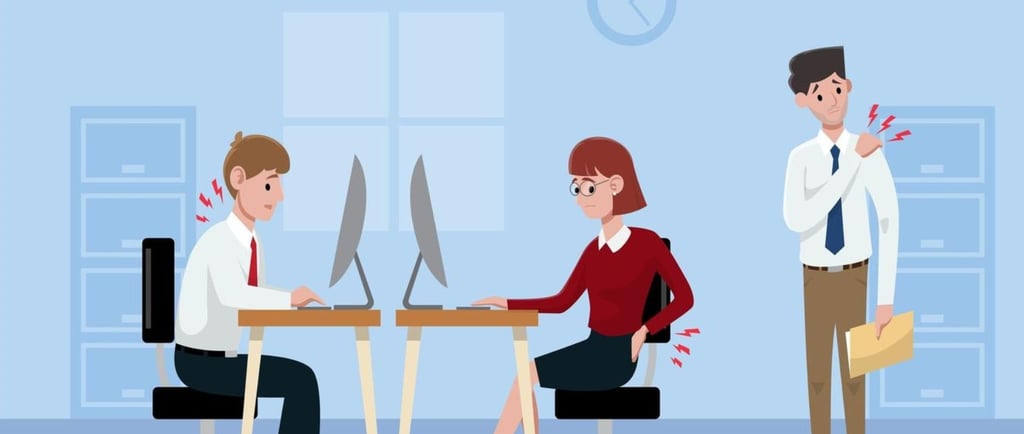How Office Syndrome is Impacting the Modern Workforce
In today’s fast-paced and digital-driven world, office work has become increasingly sedentary. Long hours at desks, slumped postures, and the overuse of computers and smartphones have given rise to a new epidemic: Office Syndrome. This term encompasses a range of musculoskeletal disorders and discomforts caused by poor posture, repetitive motions, and prolonged sitting — issues that are affecting a growing number of professionals. In this article, we’ll explore what office syndrome is, how it impacts workers, and strategies for prevention and treatment.
12/25/20245 min read


How Office Syndrome is Impacting the Modern Workforce
In today’s fast-paced and digital-driven world, office work has become increasingly sedentary. Long hours at desks, slumped postures, and the overuse of computers and smartphones have given rise to a new epidemic: Office Syndrome. This term encompasses a range of musculoskeletal disorders and discomforts caused by poor posture, repetitive motions, and prolonged sitting — issues that are affecting a growing number of professionals. In this article, we’ll explore what office syndrome is, how it impacts workers, and strategies for prevention and treatment.
1. What is Office Syndrome?
Office Syndrome refers to a set of physical ailments that arise from sitting for extended periods and engaging in repetitive tasks common in office environments. These symptoms can include:
Neck and shoulder pain
Back pain
Carpal tunnel syndrome
Tension headaches
Eye strain
Wrist and hand pain
The condition is often linked to poor posture, inadequate ergonomics, and lack of physical activity throughout the day. As people work longer hours in front of screens and adopt unhealthy postures, the strain on their muscles and joints can lead to both acute and chronic discomfort.
2. The Causes of Office Syndrome
The causes of office syndrome are largely tied to modern working habits and office environments. Here are some common culprits:
Prolonged Sitting
Sitting for long periods without breaks or movement can lead to poor circulation, muscle stiffness, and joint discomfort. Many office workers spend hours in a seated position, which puts undue pressure on the spine, lower back, and legs.
Poor Posture
Slouching or hunching over while sitting at a desk is one of the most common contributors to office syndrome. A misaligned spine, forward-leaning neck, or slumped shoulders can cause muscle tension and strain over time.
Ergonomics
Incorrect desk setup is another significant factor. Chairs that lack lumbar support, desks that are too high or low, or improper monitor heights can lead to awkward body positions that strain muscles and joints. Additionally, improper keyboard and mouse placement can lead to repetitive stress injuries like carpal tunnel syndrome.
Overuse of Technology
Constant typing, mouse usage, and prolonged screen time without adequate breaks can also lead to physical strain. Staring at screens for too long can cause eye strain and headaches, while repetitive hand movements can cause pain in the wrists, elbows, and fingers.


3. How Office Syndrome Affects the Modern Workforce
Office syndrome doesn’t just affect physical well-being; it can also have a significant impact on productivity, morale, and overall job satisfaction. Here’s how:
Reduced Productivity
Employees suffering from office syndrome often experience pain and discomfort that can reduce focus and concentration. Chronic discomfort can lead to frequent breaks, lower energy levels, and even absenteeism. This ultimately affects productivity and performance in the workplace.
Increased Health Costs
Companies may face increased health insurance claims, workers' compensation costs, and disability claims as employees require treatment for office syndrome. Prolonged conditions like chronic back pain or carpal tunnel syndrome may require expensive medical interventions, physical therapy, and even surgery in some cases.
Employee Engagement and Morale
When employees experience pain or discomfort, their overall satisfaction and engagement at work can decrease. Discomfort can lead to frustration, burnout, and a lack of enthusiasm, which affects the workplace environment and team morale.
Decreased Work-Life Balance
Chronic pain caused by office syndrome can spill over into employees’ personal lives, affecting their ability to enjoy leisure activities or engage in exercise. This can contribute to stress, anxiety, and decreased overall well-being.
4. Preventing and Managing Office Syndrome
Fortunately, office syndrome is largely preventable, and there are various steps employees and employers can take to minimize its impact. Here are some effective strategies:
Ergonomic Adjustments
Investing in ergonomic office furniture is one of the most effective ways to prevent office syndrome. Here’s what employees should consider:
Chair: Choose a chair with adjustable height and lumbar support to ensure a neutral spine position.
Desk Height: Adjust the desk to a height where the elbows are at a 90-degree angle when typing.
Monitor: Position the monitor at eye level to reduce neck strain. The screen should be about an arm's length away, and the top of the screen should be at or just below eye level.
Keyboard and Mouse: Keep the keyboard and mouse close to the body to minimize strain on the wrists and forearms.
Regular Breaks and Movement
Encourage employees to take regular breaks to stretch and move throughout the day. A good rule of thumb is the 20-20-20 rule: for every 20 minutes spent on a screen, take a 20-second break and focus on something 20 feet away. Additionally, standing desks and walking meetings can encourage movement and improve circulation.
Stretching and Strengthening Exercises
Stretching and strengthening exercises can help alleviate and prevent pain caused by office syndrome. Focus on stretches for the neck, shoulders, back, wrists, and legs. Strengthening exercises can help improve posture and support the muscles that are most affected by prolonged sitting.
Proper Posture
Educating employees on the importance of maintaining proper posture throughout the workday is essential. Encourage employees to sit up straight, keep their shoulders relaxed, and avoid slumping. Regular posture checks can help develop better habits.
Eye Care
To prevent eye strain, employees should adjust their screens to minimize glare, use proper lighting, and take breaks from staring at screens. The 20-20-20 rule also helps with eye strain.
Employee Well-Being Programs
Employers can offer wellness programs that include yoga, meditation, or stretching classes. Providing access to physical therapy, ergonomic consultations, and health initiatives can help employees manage and prevent office syndrome.


5. Technology and Office Syndrome
As technology continues to evolve, it brings both opportunities and challenges to workplace health. On one hand, new ergonomic products such as adjustable desks, ergonomic keyboards, and voice recognition software are improving comfort and reducing strain. On the other hand, the overuse of digital devices and screens, especially with the rise of remote work, requires more attention to posture and physical health.
The role of technology in preventing office syndrome lies in using digital tools to encourage movement, remind employees to take breaks, and even provide virtual consultations for physical therapy.
6. The Future of Office Syndrome and the Modern Workforce
The rise of flexible working arrangements, including remote work, has changed the landscape of office syndrome. While employees now have more control over their environment, many still face challenges such as improper home office setups or the temptation to sit for prolonged periods.
As companies continue to focus on employee well-being, it’s likely that office syndrome will become an area of increasing focus. With the right tools, education, and support, companies can help employees lead healthier and more productive lives, both at work and outside of it.
Conclusion
Office syndrome is a growing concern in today’s digital, sedentary work environments, but it is preventable with the right strategies. By prioritizing ergonomics, encouraging regular movement, and fostering awareness about posture and physical health, both employees and employers can mitigate the impact of office syndrome. As the modern workforce continues to evolve, addressing office syndrome will be key to maintaining a productive, healthy, and engaged workforce
Resources
Comprehensive information, practical tips, effective solutions, workplace health
Office Syndrome & Well-being
© 2024. All rights reserved. Designed by Pimclick - SEO Agency
Effective Exercises and Stretches for Relief
The Role of Workplace Wellness Programs
